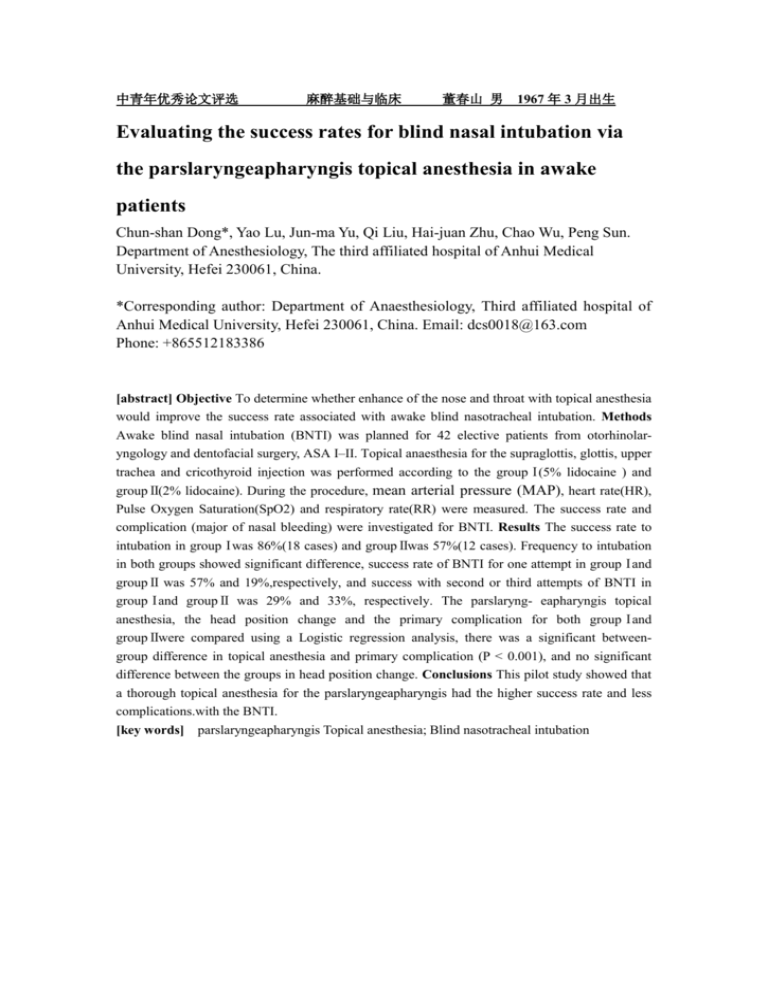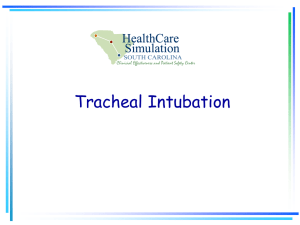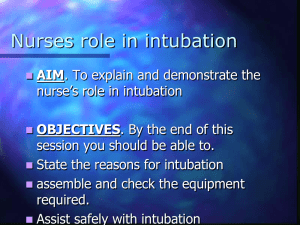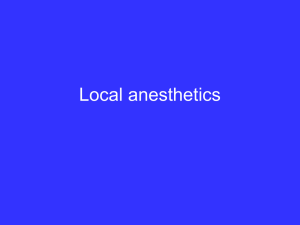2%和5%利多卡因用于清醒式盲探鼻腔气管插管成功率的比较观察
advertisement

中青年优秀论文评选 麻醉基础与临床 董春山 男 1967 年 3 月出生 Evaluating the success rates for blind nasal intubation via the parslaryngeapharyngis topical anesthesia in awake patients Chun-shan Dong*, Yao Lu, Jun-ma Yu, Qi Liu, Hai-juan Zhu, Chao Wu, Peng Sun. Department of Anesthesiology, The third affiliated hospital of Anhui Medical University, Hefei 230061, China. *Corresponding author: Department of Anaesthesiology, Third affiliated hospital of Anhui Medical University, Hefei 230061, China. Email: dcs0018@163.com Phone: +865512183386 [abstract] Objective To determine whether enhance of the nose and throat with topical anesthesia would improve the success rate associated with awake blind nasotracheal intubation. Methods Awake blind nasal intubation (BNTI) was planned for 42 elective patients from otorhinolaryngology and dentofacial surgery, ASA I–II. Topical anaesthesia for the supraglottis, glottis, upper trachea and cricothyroid injection was performed according to the groupⅠ(5% lidocaine ) and groupⅡ(2% lidocaine). During the procedure, mean arterial pressure (MAP), heart rate(HR), Pulse Oxygen Saturation(SpO2) and respiratory rate(RR) were measured. The success rate and complication (major of nasal bleeding) were investigated for BNTI. Results The success rate to intubation in groupⅠwas 86%(18 cases) and groupⅡwas 57%(12 cases). Frequency to intubation in both groups showed significant difference, success rate of BNTI for one attempt in groupⅠand groupⅡ was 57% and 19%,respectively, and success with second or third attempts of BNTI in groupⅠand groupⅡ was 29% and 33%, respectively. The parslaryng- eapharyngis topical anesthesia, the head position change and the primary complication for both groupⅠand groupⅡwere compared using a Logistic regression analysis, there was a significant betweengroup difference in topical anesthesia and primary complication (P < 0.001), and no significant difference between the groups in head position change. Conclusions This pilot study showed that a thorough topical anesthesia for the parslaryngeapharyngis had the higher success rate and less complications.with the BNTI. [key words] parslaryngeapharyngis Topical anesthesia; Blind nasotracheal intubation Nasal intubation is often required for maxillo-facial surgery, and blind intubation (BNTI) is required when there is poor mouth opening, the route is inaccessible, or when facial surgery involve the mandible or maxilla. Inability to use fibreoptic nasal intubation may not be limited to situations of unavailability ( lack of equipment, expertise, or experience). While BNTI may be appropriate, it requires special skill and has been common performed in the awake patients. The success rates of BNTI is usually poor, and BNTI may result in nasal cavity bleeding, parslaryngeapharyngis mucosa injury or bleeding. Topical anesthesia has been used successfully in the BNTI in the awake patients. In recent years, clinical practice of BNTI has effectively solved lots of difficult problems related to oromaxillo-facial region surgery, and has find crucial aspects with the topical anesthesia being blind intubation in the clinical performed. The study aims to comparing success rates of BNTI with concentration effect of topical anesthesia for the supraglottis, glottis, and cricothyroid injection of local anesthesia. Methods Gerenal data: A randomized study was undertaken in 42 patients underdoing elective surgery from otorhinolaryngology and dentofacial, which including tonsillectomy, facio-oral surgery, uvulo-palato-pharyngoplasty and tongue, other intra-oral surgery and mandibular osteotomy or mandibular reconstructive procedures. aged 7-58 year, ASA grades I–II. All the patients acquire preoperative assessment using fibre-opticlaryngocope so that clear the nasal airway is more suitable for passage as well as the structure of the bronchopulmonary is normal. Patients were excluded if they were allergic to lidocaine, had an hypertension, coagulation disorder, fracture of nasal bone and have had previous reconstructive facio-oral surgery. General methods: after obtaining written informed consent, awake blind nasal intubation was planned and explained to the patients during the preoperative visit. When the patient arrived in the operating theatre, routine monitoring was applied and intravenous access was established during they have had supin position on the operative bed. after nasal cavity was droped few of the ephedrine solution as vasoconstrictors and a soaked cotton with lidocaine solution fill desired naris, a prototype supraglottic topical device was used to anesthetize mucosa of the nasal cavity, nasopharyngeal, and oropharyngeal airway, topical anesthesia for upper tracheal mucosa was achieves using the classic cricothyroid puncture technique with injection of 2-3ml of lidocaine at the end of deep breath and after positive air, negative blood aspiration test. All the Topical anesthesia was randomly performed according to its anesthetics concentration as group Ⅰ(5% lidocaine) and group Ⅱ(2% lidocaine), n = 21/group. All the patients were given atropine 20μg.kg-1 i.m. 1 h before surgery and were given a sedative dose of midazolam HCI 0.04mg/kg i.v. 3 min before intubation. Monitoring: During the procedure, all the patients of pre- and post-procedural mean arterial pressure (MAP), heart rate(HR), Pulse Oxygen Saturation(SpO2) and respiratory rate(RR) were measured. And the number of attempts to intubate, success and failure rate were recorded. BNTI technique: 5 min after topical anesthesia, the patient was asked to rest his/her head in a slightly extended position during the procedure to allow maximal visualization of anterior neck of the patient during intubation. The operator’s left hand can be used to stabilize the patient’s occiput, note that the neck is kept flexed and the head extended; the operator’s right hand holding the tracheal tube intubate into the selected anesthetized nasal cavity at an angle perpendicular to the face. The tube’s bevel should be directed laterally away from the turbinates. In order to make certain that the tube passes along the floor of the nasal cavity, the proximal end of the endotracheal tube should be pulled cephalad. The tube is gradually into the nasopharynx and then into the oropharynx as demonstrated by a sudden decrease in resistance to inserted endotracheal tube. Once the tube is beyond the nasal cavity, various aids to appraise the end of tube have been close to aditus laryngis including listening to breath sounds directly through the tube, at this point the patient was allowed to take a deep breathing and the tube is inserted into rapidly while the patient was asked to inhale. Once the tube is inserted larynx tracheal whilst coughing or inability to speak, or nasal tube breathing occurred. Tube placement was verified by means of inflation and deflation of the reservoir bag with patient respiration, by chest auscultation, and SpO2 detection. If at any time at the patient swallowed, ability to speak, or ups and downs of the stomach while inflation and deflation of the reservoir bag, the tube was withdrawn and insertion re-attempted. If three attempts were made before successful passage of the tube through the tracheal, then the method of picking up tubes in the pharynx with the aid of a forceps and advancing them into the larynx under direct vision laryngoscopy. The following’s scores as the standard for cases of difficult or easily intubation used in this study: 1 score: easily ( once inserted); 2 scores: better easily(two or three inserted ); 3 score: better difficult ( The blind nasal intubation over direct-vision advancement for successful intubation can be achieved whilst avoiding sever complication); 4 score: difficult airway ( the inability inserted by laryngoscope-aiding). The most common complication used in the study is abrasion of the nasal mucosa as the tube is repeated successful attempts resulting in epistaxis. The following scores as the standard: 1 score: no complication; 2 scores: there are somewhat uncomfortable in pharyngx-laryngx or sensation of swelling within 24 h after operative; 3 scores: epistaxis; 4 scores: nasal cavity haemorrhag. Statistical Methods Data were imported into SPSS (12.0 edition) for windows for statistical analysis. For both pre- and post-intubation, continuous variables were compared using paired Student’s t-test. The use of parametric statistics specifically for Logistic regression analysis considering P ﹤0.05 as Statistical significant. Results No significant between-group difference in values on the age , gender and body weight of the patients (seven males and six females), MAP and SpaO2 . There were 45 patients were enrolled in two groups. The overall success rate on the BNTI in GroupⅠwas 86% and in Group Ⅱ was 52%. The success rate on the one attempt was significantly higher in GroupⅠ(57%) than in Group Ⅱ(19%). The difference between preprocedural and postprocedural HR was significantly lower in GroupⅠ(85±13 bpm) than in Group Ⅱ(96±10 bpm). The position of BNTI, methods of intubation and tubes size were not significantly different between the two groups. Effects of the head position, pharyngolaryngeal topical anesthesia and postoperative nasal bleeding were analysed using the Logistic regression analysis, which with statistically significant between the groups regarding pharyngolaryngeal topical anesthesia and postoperative complications(P-value=0.000 and 0.000 respectively), and without statistically significant between the groups concerning the head position of patients (P-value=0.073).(Table and Figure). Discussion The awake BNTI was considered the most unavoidable way to intubation patients that inability to open their mouth or failed oral intubation by senior anesthetist. Thus, its popularity as an alternative to other techniques during routine anesthesia has declined, and attribute this is predominantly ascribe to the higher failing rates or resulting in increased complications during intubation as well as some defects for example the intubation time may be prolong and the ventilation were impacted that inappropriate the tube size. Therefore, This study tried to achieve it with the use of topical anesthetics prior to BNTI and evaluating the success rates of BNTI associated with topical anesthetics of the different concentration as well as some affects with a combination of the patients position and patients head position. Table: The effect factors of BNTI by analyzing using Logistic regression analysis B coefficient(α) -0.802 topical anesthesia (β1 ) -5.171 head position (β2) 1.360 complication (β3 ) -6.463 S.E P 1.429 0.760 1.783 0.000* 0.073 0.000* EXP(B) 8.297 3.896 3.685 95% C.I for EXP(B) 28.105-2.449 17.266-0.879 16.018-0.848 The variable (B), standard error (S.E), P value (P), Explained variable and confidence interval (C.I) for explained variable of the patients; data including coefficient (α), topical anesthesia(β1), head position(β2), complication(β3). * P ﹤0.05 Few recent study suggested that the majority influence to BNTI may be rest with the patients position when was inserted or the pharyngolaryngeal related with the anatomy. The regional anatomy of nasopharynx is relatively complex passageway that are separated anteriorly by the palate. The pharynx is a U-shaped fibromuscular structure that extends from the base of the skull to the cricoids cartilage at the entrance to the esophagus. The “ sniffing” gesture was considered the ideal position for BNTI in awake patients. But the patients with cervical spine instability is contraindicated in the presence of the gesture[1]. A neutral head position combined with cuff inflation result in comparable success rates (84%) was described by Yung-Tai in 2003[2]. The success rate of the BNTI for the patients who had a topical anesthesia with 5% lidocaine would have reached 86% (18/21) in our study, and had the technique been adopted initially in all cases. The application of a 5% lidocaine of pharyngolaryngeal topical anesthesia significantly reduced the amount of swallowing reflex experienced by patients during nasal intubation. The study suggested that the importance of rotating of endotracheal tube in the esophagus because most failures may occur when the tip of the endotracheal tube, when drawn back from the esophagus, is located on the improper side of the pharynx to permit passage of the nasogastric tube[3]. In addition, successful intubation and regional anesthesia of the larynx require detailed knowledge of the laryngopharynx which are innervared by the recurrent laryngeal nerve, vagus and glossopharyngeal nerve. The glossopharyngeal nerve innervates the roof of the pharynx, the tonsils and the undersurface of the soft palate. The vagus provides sensory supply to the larynx between the epiglottis and the vocal cords, and all the muscles confined to the larynx are innervated by the recurrent laryngeal nerve except the cricothyroid muscle. For example, bilateral injury to the vagus nerve affects both the superior and the recurrent laryngeal nerve. Thus, bilateral vagal denervation produces flaccid, midpositioned vocal cords similar to those see after succinylcholine administration[4]. In this view, as in the case of awake intubation, the high-efficiency topical anesthesia of patient’s pharyngolaryngeal to BNTI is essential, even though the aberration of nasal anatomy and the use of fiberoptic bronchoscope for nasotracheal intubation are common; nasal septal deviations and septal spurs together with hypertrophy of the turbinates frequently mean that one nasal airway is more suitable for passage of a tube than the other[5]. Adam and colleague found that application of topical lidocaine and phenylephrine for the nose and tetracaine with benzocaine spray for the throat prior to nasogastric intubation results in significantly less pain and discomfort than use of a nasal surgical lubricant alone[6]. Prior to initiation of this study all anesthesiologist were instructed in the use of a standardized method of nasal intubation facilitated by including fibreoptic intubation and the possibility of performing an emergency tracheostomy. Similarly, topical anesthesia has been described in other study about the nasotracheal intubation in the awake patient[7]. Noorily et al found that topical tetracaine mixed with oxymetazoline was a superior nasal anesthetic in comparison with lidocaine or cocaine[8]. Chuah et al compared a pharyngeal 15% lidocaine spray with placebo in 100 patients undergoing upper gastrointestinal endoscopy with intravenous sedation and found no benefit of topical anesthesia in terms of ease of intubation or patient tolerance of the procedure[9]. However, these results in patients receiving intravenous sedation cannot be extrapolated to nasogastric intubation in the Erectile Dysfuntion setting. That is the utility of these various anesthetics both individually and in various combinations prior to performing BNTI remains controversial. while our study clearly indicates that BNTI may be associated with efficient topical anesthesia of parslaryngeapharyngis. it is possible with proper anesthetics concentration for topical anesthesia of the nose and pharynx to significantly increase the success rate associated with this procedure. Both the failing rate and the complication from gagging associated with BNTI were also significantly less in patients who received higher concentration anesthetics and compared with patients who were received with light concentration anesthetics. Clearly any efforts to reduce the failing and complication associated with BNTI should address both pharyngeal and laryngeal passages. However, we are aware of prior studies evaluating the combined utilities of nasopharyngeal and parslaryngeapharyngis topical anesthesia and vasoconstriction specifically for BNTI. While a significant between-group difference in the success rate and complication of BNTI is recommended, this did not translate into any difference in the operator’s assessments of the ease of BNTI. Most operator had little the difference of clinical experienced in both the Pre-operative assessment and Preparation of the nasal mucosa. Furthermore, the difference in the amount of complication between the groups may be not associated with any difference in the number of attempting required for successful intubation. Finally, there was also no difference in the frequencies of adverse events such as vomiting and choking. In conclusion, This study demonstrates that use of 5% lidocaine for the parslaryngeapharyngis Topical anesthesia prior to awake BNTI results in significantly increase success rate and less complication than use of 2% lidocaine. Widespread use of the higher concentration topical anesthetics prior to BNTI in awake patient is recommended. Close attention to proper and gentle technique as well as use of size appropriate and softer trachea tube reinforced by steel when possible may also reduce the complication associated with BNTI. References [1] Magill IW, Macintosh RR, Hewer CL, Nosworthy MD, McConnell WS. Blind nasal intubation, in ‘Lest we forget’. Anaesthesia, 1975; 30: 476-479. [2] Yung TC, Maw SS, Hung SW. Blind nasotracheal intubation is facilitated by neutral head position and endotracheal tube cuff inflation in spontaneously breathing patients. Canadian Journal of Anesthesia, 2003; 50: 511-513. [3] Lee DS, Yang CI. Suction Catheter-guided Nasotracheal Intubation. Anesthesiology, 1997; 87(2): pp 449-450. [4] Morgan GE, Mikhail JMS, Murray Mj. Clinical Anesthesiology. Third edition, Copyright (c) 2002 by The McGraw-Hill Companies, Inc; page: 60. [5] Smith JE, Reid AP. Identifying the more patent nostril before nasotracheal intubation. Anaesthesia, 2001; 56: 258–262. [6] Adam J, Singer MD, Nadine K. Comparison of Topical Anesthetics and Vasoconstrictors vs Lubricants Prior to Nasogastric Intubation: A Randomized, Controlled Trial. Academic Emergency Medicine, 1999; 6(3): 184-190. [7] Lee CM, Song KS, Morgan BR, Smith DC, Smithson JB, Sloane RW, Hickey MS. Aspiration of an Oropharyngeal Airway during Nasotracheal Intubation. Trauma-Injury Infection & Critical Care J, 2001; 50(5): pp 937-938. [8] Noorily AD, Noorily SH, Otto RA. Cocaine, lidocaine, tetracaine: which is best for topical nasal anesthesia? Anesth Analg. 1995; 81:724–727. [9] Chuah SY, Crowson CP, Dronfield MW. Topical anesthesia in upper gastrointestinal endoscopy. Br Med J 1991; 303: 695. 联系地址:合肥市淮河路 390 号(合肥市第一人民医院麻醉科)邮编 230061 通讯作者: 董春山 e-mail:dcs0018@163.com







